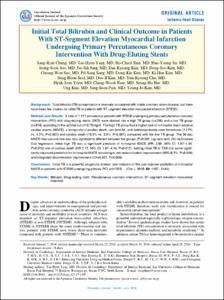KUMEL Repository
1. Journal Papers (연구논문)
1. School of Medicine (의과대학)
Dept. of Internal Medicine (내과학)
Initial Total Bilirubin and Clinical Outcome in Patients With ST-Segment Elevation Myocardial Infarction Undergoing Primary Percutaneous Coronary Intervention With Drug-Eluting Stents.
- Keimyung Author(s)
- Cho, Yun Kyeong; Yoon, Hyuck Jun; Nam, Chang Wook; Hur, Seung Ho
- Department
- Dept. of Internal Medicine (내과학)
- Journal Title
- Circulation Journal.
- Issued Date
- 2016
- Volume
- 80
- Issue
- 6
- Keyword
- Bilirubin; Drug-eluting stent; Percutaneous coronary intervention; ST-segment elevation myocardial infarction
- Abstract
- Background: Total bilirubin (TB) concentration is inversely associated with stable coronary artery disease, but there
have been few studies on initial TB in patients with ST-segment elevation myocardial infarction (STEMI).
Methods and Results: A total of 1,111 consecutive patients with STEMI undergoing primary percutaneous coronary
intervention (PCI) with drug-eluting stents (DES) were divided into a high TB group (n=295) and a low TB group
(n=816) according to the optimal cut-off 0.79 mg/dl. The high TB group had a higher rate of in-hospital major adverse
cardiac events (MACE), a composite of cardiac death, non-fatal MI, and definite/probable stent thrombosis (14.2%
vs. 4.2%, P<0.001) and cardiac death (13.9% vs. 3.9%, P<0.001) compared with the low TB group. The 30-day
MACE-free survival rate was also significantly different between the groups (P<0.001, log-rank test). On multivariate
Cox regression, initial high TB was a significant predictor of in-hospital MACE (HR, 2.69; 95% CI: 1.67–4.34,
P=0.010) and of cardiac death (HR 2.72, 95% CI: 1.67–4.44, P=0.012). Adding initial TB to TIMI risk score significantly
improved prediction for in-hospital MACE according to net reclassification improvement (NRI=5.2%, P=0.040)
and integrated discrimination improvement (IDI=0.027, P=0.006).
Conclusions: Initial TB is a powerful prognostic marker, and inclusion of this can improve prediction of in-hospital
MACE in patients with STEMI undergoing primary PCI with DES.
- Publisher
- School of Medicine
- Citation
- Sang-Ryul Chung, MD et al. (2016). Initial Total Bilirubin and Clinical Outcome in Patients With ST-Segment Elevation Myocardial Infarction Undergoing Primary Percutaneous Coronary Intervention With Drug-Eluting Stents. Circulation Journal., 80(6), 1437–1444. doi: 10.1253/circj.CJ-15-1397
- Type
- Article
- ISSN
- 1346-9843
- Appears in Collections:
- 1. School of Medicine (의과대학) > Dept. of Internal Medicine (내과학)
- 파일 목록
-
-
Download
 oak-2016-0129.pdf
기타 데이터 / 921.73 kB / Adobe PDF
oak-2016-0129.pdf
기타 데이터 / 921.73 kB / Adobe PDF
-
Items in Repository are protected by copyright, with all rights reserved, unless otherwise indicated.